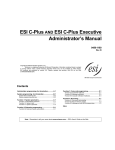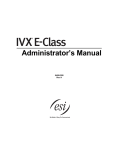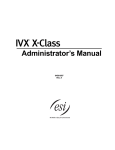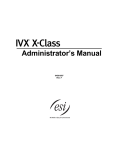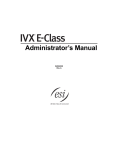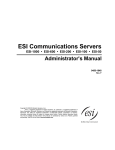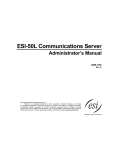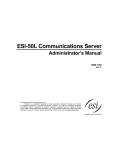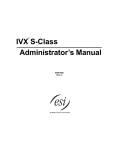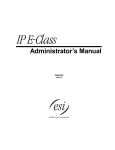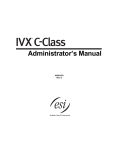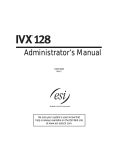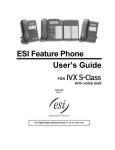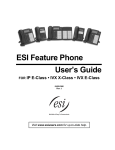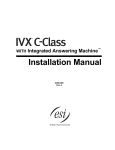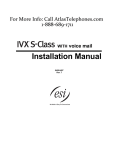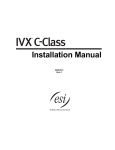Download ESI IVX X-Class User`s guide
Transcript
Administrator’s Manual 0450-0458 Rev. K Note: The IVX S-Class model with Integrated Answering Machine was discontinued March 16, 2007. However, the IVX S-Class model with voice mail remains in the ESI product line. About ESI ESI (Estech Systems, Inc.) is a privately held corporation based in Plano, Texas. Founded in 1987, ESI designs and builds innovative telecommunications products for businesses like yours. Because of their powerful combination of value and features, ESI products are consistently recognized by industry publications and leaders. Copyright © 2007 ESI (Estech Systems, Inc.). IVX is a registered trademark, and Esi-Dex, Integrated Answering Machine, and Verbal User’s Guide are trademarks, of ESI. CompactFlash is a registered trademark of SanDisk Corporation. Motorola and ColdFire are registered trademarks of Motorola, Inc. Texas Instruments is a registered trademark of Texas Instruments Corporation. Rayovac is a registered trademark of Rayovac Corporation. Act! is a registered trademark of Symantec Corporation. Goldmine is a trademark of Goldmine Software Corporation. Microsoft, Windows, NT and Outlook are registered trademarks of Microsoft Corporation. Velcro is a registered trademark of Velcro Industries B.V. Panasonic and DBS are registered trademarks of Matsushita Electric Corporation of America. Smart Jack is a trademark of Westell Technologies, Inc. Information contained herein is subject to change without notice. ESI products are protected by various U.S. Patents, granted and pending. ESI is an ISO 9001:2000-certified company. Visit ESI on the Web at www.esi-estech.com. Table of contents Administrator programming: An introduction......................................................................................................A.1 Administrator duties .....................................................................................................................................................................................A.1 Feature Phone overlays ..............................................................................................................................................................................A.3 Programming basics....................................................................................................................................................................................A.3 System programming overview ..................................................................................................................................................................A.4 Programming keys.......................................................................................................................................................................................A.5 Entering alphanumeric characters..............................................................................................................................................................A.5 System fixed numbering plan......................................................................................................................................................................A.6 Remote setting of day, night, holiday and auto modes.............................................................................................................................A.7 Function 1: System parameters .............................................................................................................................B.1 Function 13: Administrator password .......................................................................................................................................................B.1 Function 14: System clock ..........................................................................................................................................................................B.2 Function 17: System speed-dial..................................................................................................................................................................B.3 Function 3: Extension programming .....................................................................................................................C.1 Function 32: Extension feature authorization.............................................................................................................................................C.1 Function 37: RFID programming ................................................................................................................................................................C.3 Function 5: Voice mail programming ....................................................................................................................D.1 Function 53: Guest/info mailboxes .............................................................................................................................................................D.1 Broadcast mailbox........................................................................................................................................................................................D.2 Function 54: Answering Machine members — MB501............................................................................................................................D.2 Function 55: Message notification ..............................................................................................................................................................D.3 Function 56: Cascade notification mailboxes ............................................................................................................................................D.5 Function 6: Recording .............................................................................................................................................E.1 Function 61: Re-record main greeting........................................................................................................................................................E.1 Function 62: Record directory names ........................................................................................................................................................E.2 Function 63: Message-on-hold (MOH) programming...............................................................................................................................E.3 Feature description: SMDR.................................................................................................................................... F.1 Tabular SMDR format.................................................................................................................................................................................. F.1 CSV SMDR format....................................................................................................................................................................................... F.2 Reporting conventions and rules ................................................................................................................................................................ F.3 SMDR format when using account codes ................................................................................................................................................. F.4 Index (This page included for pagination purposes only.) IVX S-Class Administrator’s Manual Administrator programming: An introduction Administrator programming: An introduction You can program an IVX S-Class system from a 24 or 48-Key Digital Feature Phone in the system (while the system is operating). Read the S-Class User’s Guide first. Programming features require a clear understanding of user interface and application. Once you’ve accessed programming mode on a 24 or 48-Key Digital Feature Phone, the system will prompt for — and confirm — each keystroke action via voice commands and the display. You program both configuration data and recordings in the same manner. Note: This manual uses the term Generation II to refer to IVX S-Class systems introduced in 2004. Important: During programming, the 24-Key Feature Phone’s two-line display shares the same content as the top two lines of the 48-Key Feature Phone’s three-line display. As a result, to save space, the sample displays shown herein will show only two lines. References throughout this manual to separate PROGRAM and HELP keys are valid for only the 48-Key Digital Feature Phone. On the 24-Key Digital Feature Phone, the two keys are combined into one PROG/HELP key, which is to be used in place of the separate keys. Administrator duties The System Administrator can perform the following tasks. • Administering station assignments. • Managing station feature authorization. • Maintaining the employee directory (if used). • Re-recording system prompts. • Administering manual change of day/night mode (if required). • Training new employees on the system’s operation Telephone system features • ESI Feature Phones — Compact and stylish, yet rugged, the 48-Key Digital Feature Phone and the 24-Key Digital Feature Phone each include a high-quality speakerphone, an informative multifunctional display, and a specially designed key layout with several dedicated keys to minimize or eliminate the need to memorize codes. An Expansion Console is available for the 48-Key Digital Feature Phone; and each 48-Key Feature Phone model includes an integrated headset jack. ESI also offers the 12-Key Digital Feature Phone with similar design and basic functions. At least one 24or 48-Key Digital Feature Phone must be purchased with each S-Class system. Also available: ESI’s Digital Cordless Handsets. ™ • Extensive help — Easily accessible with one press of the HELP key, ESI’s Verbal User’s Guide uses spoken and displayed help prompts to help everyone from the Installer through the Administrator down to the least experienced end user. You may also go to www.esiusers.com for online help. 1 • Intelligent Caller ID — Allows one-touch automatic message return. • Live call recording — Can record any conversation or personal memo along with moving or copying 2 of any recording to another user’s voice mailbox. 1 2 This and all other references to Caller ID service within this manual assume the end-user organization subscribes to Caller ID service from its telephone service provider. Not available on 12-Key Feature Phone. A.1 Administrator programming: An introduction IVX S-Class Administrator’s Manual • Call waiting — Includes helpful display, showing both calls’ Caller ID information, and easy one-key toggling between calls. • Conference calling — Includes two conference bridges, and a conference may contain up to four parties, so the IVX S-Class system can support two conferences of four parties each. Analog phones on the system also may initiate conferences. ™ • Esi-Dex speed-dialing — Calls any number using three separate lists (personal, station, and 1 system); uses Caller ID information or direct keypad entries. • Dedicated overhead paging interface — Allows for external paging through overhead speakers or multi-zone paging units (amplification required) • 911 alert — Provides immediate line access if any station with line access dials 9 1 1 to report an emergency; sends a message via the serial port indicating the start date, time, station number and end-time of the 911; also sounds an audible warning at the operator station and displays, for example: 911 CALL FROM X102 JOHN JAMES • Status indicator lamp — Indicates three conditions of the 48- and 24-Key Digital Feature Phone: off-hook, ringing, and new voice mail message. 2 • NSP (Network Services Processor) — Allows system programming via TCP/IP and can be adapted to fit a variety of phone system configurations, small to large. • Support for these options (for more details, see www.esi-estech.com or consult your ESI Reseller): ™ – VIP and VIP Professional — Each provides a value-added interface to an IVX X-Class system. Delivers call control and unified messaging to Microsoft® Outlook® 2000/2002/2003. 3 – VIP PC Attendant Console — Gives the user all the features of VIP Professional plus an expanded Call Display and 200 virtual programmable feature keys to support the busy attendant. – ESI Presence Management — Provides integrated building entry control, access control, status indication, personal call routing, and (optionally) time and attendance management. Voice mail features ™ • Quick Groups — Makes it easy to leave voice mail messages for several users. ™ 1 • Quick Move — Records a conversation into another user’s mailbox. ™ 1 • Virtual Mailbox Key allows easy monitoring of a second mailbox. 1 • Different mailbox types, including cascade, guest, and broadcast. 4 • IVX S-Class with Integrated Answering Machine can record up to two simultaneous calls. Messages can be retrieved by any authorized 12, 24 or 48-Key Feature Phone or remotely from an off-premises location. The system can also be programmed to either call an off-premises number or commercial network to deliver messages. • Message-on-hold recordings — Up to five recording: three prerecorded, one customized, and one live entry. • Message Recycle Bin (undelete) — Remembers, and can restore, each mailbox’s 10 most recently deleted messages. This feature is also available on the Integrated Answering Machine (mailbox 501). 1 2 3 4 Not available on 12-Key Feature Phone. If ordered at purchase. Not available as an upgrade. Previously known as ESI PC Attendant Console. This model was discontinued on March 16, 2007. A.2 IVX S-Class Administrator’s Manual Administrator programming: An introduction Feature Phone overlays Each ESI Feature Phone comes with one overlay for the programmable feature keys. To order ™ additional overlays, visit the DESI Web site at www.desi.com. You can also download the free ® Windows -based software, DESI Lite, which allows you to print on the overlays. For assistance with DESI products, please consult the DESI Web site. Tip: Remember that ESI’s Esi-Admin software, available from your ESI Reseller, also lets you print on the overlays as well as perform certain programming tasks. Programming basics 1 You may program from any 24-Key or 48-Key Digital Feature Phone in the system: 2 1. Press PROGRAM at any digital station. The normal station programming menu prompts will begin to play. 2. Press HOLD. The “enter password” prompt will play. 3. Enter the Administrator password (default is 4 5 6). Then, to confirm the password, either press # or wait two seconds. You are now in programming mode. The extension will be automatically placed in DND, and its display will show: ADMINISTRATOR CMD: 4. The system will play the system programming menu. Follow it to program as you wish. 4. The system will play the system programming menu. Follow it to program as you wish. 5. When finished, hang up. Warning: Always FINISH programming in ANY function BEFORE exiting programming mode (as needed, press # to accept current entries for function parameters you’re not changing). Note: The system will automatically exit programming mode after 10 minutes of inactivity. Example: If your Administrator password is 864, enter programming mode by pressing PROGRAM HOLD 8 6 4 #. (To exit programming mode, hang up.) 1 2 Although a 12-Key Feature Phone allows you to enter Installer and Administrator programming, we don’t recommend that you use a 12-Key Feature Phone for programming because of its one-line display and small number of programmable feature keys. Or, if using the 24-Key Feature Phone, press PROG/HELP. A.3 Administrator programming: An introduction IVX S-Class Administrator’s Manual System programming overview The following menus show the programming functions available on S-Class systems. For S-Class with four-port or two-port voice mail, see the first menu; for S-Class with Integrated Answering Machine, refer to the second menu. Programming menu for S-Class with voice mail and auto attendant 1 System parameters 13 Administrator password 14 System clock 141 Set time/date 142 Automatic time setting 143 Clock adjustment (Generation II only) 17 System speed-dial 3 Extension programming 32 Extension feature authorization 37 RFID programming 371 Access schedules 372 RFID tag programming 373 View RFID tag numbers 374 ESI Presence Management parameters 375 RFID Reader parameters 5 Voice mail programming 53 Guest/info mailboxes 55 Message notification options 551 Station delivery options 552 Delivery/paging parameters 56 Cascade notification mailboxes 6 Recording 61 Record system prompts 62 Record directory names 63 MOH programming 631 MOH source 632 Record MOH 633 MOH volume Programming menu for S-Class with Integrated Answering Machine1 1 System parameters 13 Administrator password 14 System clock 141 Set time/date 142 Automatic time setting 143 Clock adjustment (Generation II only) 17 System speed dial 3 Extension programming 32 Extension feature authorization 1 This model was discontinued on March 16, 2007. A.4 5 Voice mail programming 54 Answering Machine members 55 Message notification options 6 Recording 63 MOH programming 631 MOH source 632 Record MOH 633 MOH volume IVX S-Class Administrator’s Manual Administrator programming: An introduction Programming keys During programming, the first line of the display will show the current item being programmed, and the second line will be the entry line. You can enter values as directed by the combination of the voice prompts and display. To enter multiple values, such as a list of extension numbers, separate each value by # (to exit the list, enter # #). To... Press ... Enter # Back up (i.e., reverse direction) Delete Exit Help Select/scroll HOLD [Hang up] HELP (left-side scroll key) (right-side scroll key) What this does Confirms new or existing entry and advances to next programming step. Backs up to previous prompt without changing its value. Deletes data or recording. Exits programming mode and removes extension from DND. Provides more detailed instructions during programming. • During entry of a value, backs up. • If a list is present (“>” is displayed), scrolls to left. • Selects from options presented. • If a list is present (“>” is displayed), scrolls to right. • Inserts a space during entry of a name. Entering alphanumeric characters You enter names for extensions, departments, and branch IDs by pressing the dial pad key that corresponds to the character to be entered. The key’s possible entries will change each time the key is pressed, and the display will show this. When the desired character appears on the display, press # to confirm; the cursor will move to the next character position. You may move the cursor left (to correct an entry) by pressing the left scroll key () or move right (to add a space) by pressing the right scroll key (). Key 0 1 2 3 Options 0, - (hyphen), _ (underline) Q, Z, 1, “_” (space) A, B, C, 2 D, E, F, 3 4 G, H, I, 4 5 6 J, K, L, 5 M, N, O, 6 Key 7 8 9 (left scroll key) (right scroll key) # ## Options P, R, S, 7 T, U, V, 8 W, X,Y, 9 Backs up and erases Adds a space [Enter] Ends the name Example: To enter a B, press 2 twice (the possible options to scroll through are A, B, C and 2). When B is displayed, press # to confirm; the cursor will move to the next character to be entered. To complete the name, press # #. A.5 Administrator programming: An introduction IVX S-Class Administrator’s Manual System fixed numbering plan Numbers Generation II Generation I 0 1–16 100–131 132–139 199 0 1–16 100–123 124–129 199 290–299 1 300–489 500 520–529 560–580 590–594 600–699 300–309 Function Operator CO lines Digital extensions Analog extensions Overhead paging port Department numbers Guest/info mailboxes Broadcast mailbox Cascade mailboxes Feature codes MOH recordings System speed-dial Note: If unsure whether your IVX S-Class system is Generation I or Generation II, consult your ESI Reseller. Alternatively, if you have physical access to the IVX S-Class system cabinet, see whether the text “Generation II” appears in small lettering on the cover’s label. 1 If using system software version 4.7.0 or later; otherwise, same as Generation I. A.6 IVX S-Class Administrator’s Manual Administrator programming: An introduction Remote setting of day, night, holiday and auto modes Normally, the system’s day/night mode operation will be manually controlled at an ESI Feature Phone and/or set to follow the day/night mode tables (programmed by the Installer) automatically. In addition, the Administrator can remotely change the mode and/or re-record the holiday greeting to handle unexpected closings such as for inclement weather. Remotely logging into the system with the Administrator password lets the caller re-record the ID 1 greetings (day and night) and the holiday greeting, as well as change the mode to day/night/holiday (or auto). 1. At the main greeting, enter 4 5 6 # — or [the new password] # — to enter remote programming mode. 2. You’ll hear prompts that will allow you to change the answer mode (day, night, holiday, or auto) and/or to re-record the holiday greeting and the main greeting (ID 1). Follow the prompts to perform the desired operation. 3. Exit by pressing and hanging up. Prompts for remote settings: an outline 1 Set answer mode 1 2 3 4 Day mode Night mode Holiday mode Use day/night table* 2 Record holiday main greeting 3 Record daytime main greeting 4 Record nighttime main greeting Note: If the system is answered live and call is then routed to a mailbox., the Administrator can press 8 to return to the main greeting and then follow the steps for making remote settings. * This is used if the Installer has programmed an automatic calendar. A.7 Administrator programming: An introduction IVX S-Class Administrator’s Manual (This page included for pagination purposes only.) A.8 IVX S-Class Administrator’s Manual Function 1: System parameters Function 1: System parameters Function 13: Administrator password This will display the existing password and prompt for entry of a new password. The password can be 2–8 digits long, followed by #. The default Administrator password is 4 5 6. Note: Be sure to write down the new password, and store it in a safe place. Accessing user station programming Should a user forget his password or if an employee leaves the organization, this feature allows the Installer or Administrator to enter a user's station programming and operate within it as if he were the user. From the user’s station, enter the Administrator password when the system prompts for the user password. Example: From station 105, entering 4 5 6 # instead of the user password (1 0 5 #) will enter the station’s user programming. (Default Administrator password shown for this example). B.1 Function 1: System parameters IVX S-Class Administrator’s Manual Function 14: System clock Function 141: Set time/date 1. Enter a new time in a twelve-hour format. Example: Enter 1 2 3 3 for 12:33, or 3 1 5 for 3:15 (note that you need no leading zero for the time). 2. Select AM or PM by pressing a scroll key (either or ). 3. Enter a new date in an eight-digit format, including leading zeroes. Example: Enter 0 7 0 4 2 0 0 6 for July 4, 2006 (note that leading zeroes are required here, unlike in Step 1). 4. Press # to finish the entry. Note: A built-in battery maintains the correct time and date, even in the event of a power loss. Function 142: Automatic time setting 1: Synchronize with CID This function, when enabled, synchronizes the real-time clock with Caller ID (CID) messaging: call processing compares the time of a CID message to the system real-time clock and, if the difference is more than two minutes, resets the real-time clock to match the time (hours and minutes) of the CID message. The system will analyze each such message (or — if it receives more than four calls with CID information within a one-minute period — as is needed). Select ENABLE or DISABLE by pressing a scroll key (either or ). Choosing ENABLE will allow the CID data to update the time and date. Default: Enabled. 2: Adjust for Daylight Saving Time This function, when enabled, causes the real-time clock to adjust itself automatically for Daylight Saving Time (DST). Select AUTO or DISABLE for DST by pressing a scroll key (either or ). Choosing DISABLE is best for those areas that don’t observe DST. Default: Disabled. Note: If this function is enabled and it causes an automatic time change, the system won’t update the real-time clock from Caller ID messages (Function 1421, above) for 25 hours before and 25 hours after the time change is due to be effective (i.e., 2:00 AM Sunday). Function 143: Clock adjustment This function lets the Installer or Administrator have the system automatically compensate for a clock that’s running too fast or too slow. The clock adjustment speeds up or slows down the clock over a 30-day period by the amount selected. If the system clock is running slow, select a positive value. If the clock is running fast, select a negative value. Range: -2 to +5.5 minutes. Default: 0. Example: B.2 If the clock is running two minutes fast over a month, select -2 (minus two minutes).. IVX S-Class Administrator’s Manual Function 1: System parameters Function 17: System speed-dial Up to 100 system speed-dial names and associated numbers can be stored, in location numbers 600–699, for access by any station. A user can initiate a system speed-dial by dialing the speed-dial location number or by accessing the name through the Esi-Dex feature. In Function 32, access to system speed-dial can be denied to individual stations (see page C.1). Note: System speed-dialing overrides toll restrictions (Function 32, page C.1). 1. Enter the 3-digit location number to program, 2. Enter a ten-character name (see “Entering alphanumeric characters,” page A.5). 3. Enter the number to be dialed (including the line group 9, 8, or 7). Press the left scroll key () to delete any character or digit entered in error. Here’s an example: 1. Speed-dial # 601 2. Name AUTO RENTL 3. Number 915552221212 The number dialed in Step 3 can be up to 30 digits long including special characters: Code # F P What it produces # DTMF tone DTMF tone Flash hook 2-second pause Use the scroll key to enter special characters; use the scroll key to backspace. Press # to confirm the inserted character and continue. Press # # to complete the entry. Once the number is saved you can use the scroll keys to move back and forth to view the number. To edit the number, you must delete it and enter the correct number. Example: To create a System Speed-dial number that dials 9, then 972-555-5644, then pauses for four seconds and finally dials #104, enter: 9 9 7 2 5 5 5 5 6 4 4 (then scroll to) P # (then scroll to) P # (then scroll to) # # 1 0 4 # Deleting a speed-dial number To delete an entire speed-dial number and name, delete the location number (6 X X) by pressing HOLD or the left scroll key () during Step 1 in the speed-dialing procedure described above. B.3 Function 1: System parameters IVX S-Class Administrator’s Manual (This page included for pagination purposes only.) B.4 IVX S-Class Administrator’s Manual Function 3: Extension programming Function 3: Extension programming This section provides programming for extensions and department groups. Important: Where any gray shading (■) appears in an example, it represents values either unavailable to the function or unused in the particular example. Function 32: Extension feature authorization Function 321: Standard feature authorization An Administrator can allow or deny many extension features on an extension-by-extension basis. A user, however, can only program and use allowed features (by using a combination of voice and display prompts) from his/her phone. Here is an example of a completed programming worksheet. This assumes a Generation II system (for Generation I, change the last extension below to 124). The programming sequence is: 1. Ext. 2. Name XXX 100 101 102 132 Default Jane Roger Sally Bill 3. Live recdg. 4. Toll allow 5. Sys. spd.-dial 6. Ext. fwdg. 7. Ext. fwdg. to toll # 8. Trk-totrk xfer 9. Assoc. ext. Y Y Y N Y Y Y Y Y Y Y Y Y Y N N N N N N N N N N N N N N N X206 † The programming steps are: 1. Extension number — Enter the extension number to program. 2. Extension name — Name the extension (if not previously named in Installer programming). For each of the following features, press a scroll key ( or ) to select YES or NO. 3. Live recording feature — If enabled, will allow the user to record conversations. 4. Toll restriction — “YES” allows the user to place toll calls. If you select “NO,” the user can make only either non-toll calls or calls to numbers listed in the allow exception table. 5. System speed-dial — “YES” allows the user to access and place system speed-dial calls. 6. External forwarding — Allows the station user to enable the off-premises “reach-me” feature. The off-premises reach-me feature allows a caller that has been forwarded to voice mailbox to be transferred to an outside number. See the IVX S-Class User’s Guide for more information about the off-premises reach-me feature. Default: Disabled. 7. External forwarding to toll number — Used in conjunction with external forwarding, this feature, when enabled, lets the user program a long-distance number for external call forwarding. Note: After the system dials the external forwarding number, a prompt will be played saying, “You are receiving a forwarded call. Press any key to accept.” This prompt will play continuously for 30 seconds. If the forwarded call is answered and the called party dials a digit, the forwarded call will be connected to the called party. If no digit is dialed, the caller is automatically forwarded to voice mail. While the two lines (trunks) are connected, the system constantly monitors the lines for open loop conditions (hang-up). If an open loop is detected on either line, the call is disconnected. The system also monitors for voice activity on the connected lines. If voice is no longer detected, the call is disconnected. 1 Finally, if both lines are connected for more than 60 minutes , the call will be disconnected. † 1 An example of a digital Cordless Handset. The default timer can be made longer or shorter. To get this adjustment, contact ESI Technical Support. C.1 Function 3: Extension programming IVX S-Class Administrator’s Manual 8. Trunk-to-trunk transfer — When enabled, this lets the station user initiate a trunk-to-trunk transfer. The user, while connected to a CO line, can press TRANSFER, dial an off-site number and then complete the trunk-to-trunk transfer by simply hanging up. Both outside parties are then connected. Default: Disabled. Important: USE OF FEATURES, SUCH AS TRUNK-TO-TRUNK TRANSFER, THAT REQUIRE TRUNK-TO-TRUNK CONNECTIONS WILL INCREASE THE RISK OF TOLL FRAUD. IN NO EVENT SHALL ESI (ESTECH SYSTEMS, INC.) BE LIABLE FOR ANY DIRECT, INDIRECT, INCIDENTAL OR CONSEQUENTIAL DAMAGES WHATSOEVER INCLUDING, BUT NOT LIMITED TO, FRAUDULENT TOLL CHARGES, LOSS OF BUSINESS PROFITS, BUSINESS INTERRUPTIONS OR ANY OTHER COSTS OR DAMAGES RELATED THERETO ARISING FROM THE USE OF THESE FEATURES. 9. Associated extension — Enter the desired ESI Cordless Handset extension. This creates a relationship that allows use of the Quick Switch key. For information about the Quick Switch key, consult the User’s Guide (ESI # 0450-0366). This field is not available for an extension using a 12-Key Feature Phone, 16-Key Feature Phone, or ESI Cordless Handset. Function 322: Advanced extension feature authorization This function allows authorization of some other ESI features, particularly those involving licensing. Below is an example of a completed programming worksheet. The programming sequence is: 1. Ext. 2. Name 3. VIP 4. Type 5. Auto-record 6. Record threshold XXX 100 101 102 110* Default Jane Roger Sally Bill N Y Y Y N Attendant Pro VIP N Y 30 1. Ext. — Enter the extension number to program. 2. Name — Enter the name of the extension. Note: For more information on the VIP, VIP Professional, and VIP PC Attendant Console products and features mentioned in steps 3–6, refer to the VIP Setup and User’s Guide (ESI # 0450-0513). 3. VIP — Scroll to enable (YES) or disable (NO) the extension to use VIP, VIP Professional, or VIP PC Attendant Console. 4. Type — Scroll to select which type of VIP application the extension can use. Choices: VIP (regular VIP), PRO (VIP Professional), and ATTEND (VIP PC Attendant Console). 5. Auto-record — Scroll to enable (YES) or disable (NO) the extension for auto-record. This feature 1 requires appropriate licensing and is available only for users of VIP Professional and VIP PC Attendant Console. 6. Record threshold — Enter the number of auto-recordings that an authorized extension can make before all recording functionality is disabled. For information on auto-recording, consult the VIP Setup and User’s Guide (ESI # 0450-0513). Range: 5–15. Default: 10. * An example of an analog phone. 1 The system supports up to two auto-record licenses. C.2 IVX S-Class Administrator’s Manual Function 3: Extension programming Function 37: RFID programming This function relates to ESI Presence Management only, and covers several steps needed to: • Program RFID tags. • Access scheduling. • View tag numbers. • Set ESI Presence Management parameters. Note: Not available on IVX S-Class with Integrated Answering Machine (discontinued March 16, 2007). For more information about ESI Presence Management, consult its Installation Manual (ESI # 0450-0792). Function 371: Access schedule programming Access schedules are used to allow or deny door access with electronic keys (“RFID tags” on the system display) at certain times of the day. Up to seven access schedules can be programmed. Each schedule has an allow access time and a deny access time for each day of the week. By default, all access schedules allow access 24 hours a day, seven days a week. Note: Access schedules don’t take effect until the current time has passed the next schedule time. For example: if you program a schedule time to deny access Wednesdays at 5:30 PM but it’s already 5:45 PM on Wednesday when this programming occurs, the change won’t take effect until the following Wednesday. 1. Using the scroll keys, select the access schedule to be programmed. Press # to confirm. Range: 1–7. Note: Schedule 0 (default of full-time access) isn’t selectable. ACCESS SCHEDULES 1-ACC SCHED1 > 2. Enter the name of the schedule (up to 10 characters in length). Press # to confirm. Default: ACC SCHED[x], where [x] represents the access schedule selected in step 1. ACC SCHED1 NAME: 3. Use the scroll keys to select the day of the week to program for the selected access schedule. Press # to confirm. ACC SCHED1 DAY: MONDAY > If you haven’t yet assigned a allow time (see next step) for this schedule, the display will show something like: ACC SCHED1 MON NO ALLOW TIME (Continued) C.3 Function 3: Extension programming IVX S-Class Administrator’s Manual 4. Enter the allow time — the time when an electronic key user can begin controlling door locks — in 12-hour format. (To delete an entry, press HOLD.) Press # to confirm when done. ACC SCHED1 MON ALLOW: 900 5. Select AM or PM by pressing a scroll key. Press # to confirm. ACC SCHED1 MON ALLOW: 900 AM If you haven’t yet assigned a deny time (next step) for this schedule, the display will show something like: ACC SCHED1 MON NO DENY TIME 6. Now, enter the deny time — the time when an electronic key user begins to be denied door lock control — in 12-hour format. (To delete an entry, press HOLD.) Press # to confirm when done. ACC SCHED1 MON DENY: 700 > 7. Select AM or PM by pressing a scroll key. Press # to confirm. ACC SCHED1 MON DENY: 700 PM 8. Press # again to exit the function, or select another day of the week by using the scroll keys and then go back to step 4. C.4 IVX S-Class Administrator’s Manual Function 3: Extension programming Function 372: RFID tag number programming As described earlier in this document, each electronic key has an embedded unique RFID tag number. This function is used to associate each RFID tag number to an extension or mailbox for Personal Call Routing and presence indication (except mailboxes). If Personal Call Routing or presence indication is not desired but access control is required, enter 0 instead of an extension or mailbox number. 1. Enter an RFID tag number, or use the scroll keys to select from the list of tag numbers. Note: If using any RFID features — i.e., if using ESI Presence Management for anything more than its doorphone capabilities — you should save time by first scanning the electronic keys at any ESI Presence Management RFID Reader connected to the system. The system will store the electronic keys’ tag numbers automatically, and you can use the scroll keys to select the tag numbers to be assigned. To delete a tag number, press HOLD.) Press # to confirm. TAG ID: 2 9012345678 > The tag ID is the list index of the RFID tag number. Note: If a tag number is entered manually but the 500-tag limit has been exceeded, “LICENSE EXCEEDED” will appear on the display. Therefore, you must either delete one or more unassigned tag numbers or purchase additional licenses to add new tag numbers. Contact your ESI Reseller for additional assistance with RFID tag licenses. 2. Enter the extension or mailbox number to which you wish to assign the tag number. If no extension or mailbox is to be assigned this tag number, press 0. (To delete an entry, press HOLD.) Press # to confirm. RFID TAG PROG EXT OR MB: 3. Enter the extension numbers of up to 10 ESI Presence Management RFID Readers for which this tag is allowed to control door access. To give the tag access to all doors, press FLASH. (To delete an entry, press HOLD.) Press # after each entry and then press # again to confirm (in other words: after the last entry, you’ll press # twice). Note: If all ESI Presence Management RFID Readers are allowed, “ALL” will appear on the second line. DOOR ACCESS: 123 124 138 > 4. Use the scroll keys to select an access schedule. Access schedules are used to allow or deny door access with an electronic key at certain times of the day. Each day of the week can have a start time to allow access and a stop time to deny access. To allow constant (“full”) door access, select 0 - FULL. Otherwise, select a schedule to restrict access. The schedule name will appear. Range: 1–7. Default: 0 (full) Note: You assign access schedules in Function 371 (see page C.3). ACCESS SCHEDULE: 0 - FULL > C.5 Function 3: Extension programming IVX S-Class Administrator’s Manual Function 373: View RFID tag number This is used to display tag numbers that are associated to extensions or mailboxes. You can only view tag numbers with this function. You cannot change any tag numbers or assignments. Enter the station or mailbox number to display, and then press #. If there’s an RFID tag number assigned to that extension or mailbox, it will appear. RFID TAG DISPLAY EXT: Tip: You can use Esi-Access or Esi-Admin to print out a list of assigned tag numbers. Function 374: ESI Presence Management parameters Playing prompts This determines whether the system plays a prompt — and, if so, which one — when the ESI Presence Management RFID Reader reads an electronic key. Select YES to enable playing of the prompt or NO to disable playing of the prompt. Default: YES (a prompt will play). EPM RFID READER PROMPTS: YES > When this function is set to NO, no prompts will play through the ESI Presence Management RFID Reader. When “EPM RFID Reader prompts” is set to YES, prompts will play as shown below. (These prompts can’t be customized.) When the RFID Reader displays: WELCOME GOODBYE ACCESS DENIED LICENSE EXCEEDED ERROR READER FULL It plays this prompt: “Welcome” “Goodbye” “Invalid Entry” “Error” “Error” Enable/disable sending time and attendance records Notes: The NSP must be programmed and connected to a local area network for time and attendance record collection. Only ESI Presence Management RFID Readers programmed as type ENTRANCE/EXIT (Function 31) generate time and attendance records. This parameter is used when the optional ESI TimeLine time and attendance management software application is used in conjunction with the ESI Presence Management RFID Reader. Use the scroll keys to enable or disable time and attendance records, and press # to confirm. Default: Disabled. C.6 IVX S-Class Administrator’s Manual Function 3: Extension programming Function 375: RFID Reader parameters This function is used to adjust the doorphone speaker volume of each RFID Reader. 1. Enter the extension number of the RFID Reader. EPM READER SET EXT: 2. Select the volume level by using the scroll keys. X211 FRONT DOOR VOLUME: 6 > Range: 1–8, with 8 as the highest. Default: 4. C.7 Function 3: Extension programming IVX S-Class Administrator’s Manual (Page inserted for pagination purposes only.) C.8 IVX S-Class Administrator’s Manual Function 5: Voice mail programming Function 5: Voice mail programming To simplify initial installation, all programmed extensions will automatically have the generic personal greeting, “You have reached the mailbox for extension [xxx].” The mailbox user should replace this with a personalized greeting. Each mailbox must have a greeting recorded for IVX S-Class to consider the mailbox active. Function 53: Guest/info mailboxes Note: Not available on IVX S-Class with Integrated Answering Machine (discontinued). 1 Mailboxes numbered 300–489 can be programmed as either a guest or info mailbox. Enter the mailbox number and select Guest or Info by pressing a scroll ( or ) key. Guest mailboxes Guest mailboxes are designed to be used by personnel, such as in outside sales or manufacturing, who don’t have an extension assigned to them. Notes: A guest mailbox can be handled like a regular extension (i.e., listed in the directory, assigned a station key, etc.), and is password-protected by default. 2 Guest mailboxes do not support AutoPage (but do support off-premises “reach-me” ). Default: 300–489 as guest mailboxes. Info mailboxes Info mailboxes can be used to give callers information on a variety of different subjects by “publishing” these mailbox numbers. Info Mailboxes are identical to Guest Mailboxes except that the caller will not be given a record tone after the personal greeting (the information to be played). Instead, the caller will be forwarded as programmed in this function (default is the caller will be disconnected after the information is played). The maximum length of the record time is 14 minutes. Guest/info mailboxes are created or deleted here, but are turned “on” only when a personal greeting (the information to be played) has been recorded. Deleting the personal greetings will turn “off” the mailbox. To record a greeting, press PROGRAM and the mailbox number; then press # to confirm, and follow the prompts. The default password is the mailbox number. (Continued) 1 2 On system software version 4.7.0 or higher. On earlier versions, only mailboxes 300–309 are guest mailboxes. On system software version 4.7.0 or higher. On earlier versions, guest mailboxes support neither feature. D.1 Function 5: Voice mail programming IVX S-Class Administrator’s Manual Below is an example of a completed Programming Worksheet, showing the sequence of programming: 1. MB 300 302 2. Name Dana Literature 3. Type Guest Info 4. CF day 5. CF night X/MB/ID X/MB/ID Each programming step is defined as follows: 1. Mailbox number — Enter a mailbox number, 300–389. 2. Name — The mailbox name is used for the display, reports, and as a programming aid. The name length can be no longer than 10 characters (see “Entering alphanumeric characters,” page A.5). Default: The Mailbox number. 3. Type — Select a mailbox type: Guest or Info. Default: Guest. 4. and 5. Call forward (info mailbox only) — An info mailbox can be set to call forward after the personal greeting has played to an extension, department, a mailbox or a branch ID for day mode and differently for night mode. Default: ID9999 (automatic disconnect). Broadcast mailbox Note: For S-Class systems with voice mail and auto attendant. Not available on IVX S-Class with Integrated Answering Machine (discontinued). Mailbox 500, the broadcast mailbox, is a special mailbox that can be used to leave messages for all of the system’s digital station users (extensions 100–131 on Generation II; extensions 100–123 on Generation I) who have recorded a personal greeting. The broadcast mailbox’s user list cannot be edited. Guest mailboxes are not included in the broadcast group. For more information, refer to the IVX S-Class User’s Guide. Function 54: Answering Machine members — MB501 Note: Applicable only to IVX S-Class with Integrated Answering Machine (discontinued). The Integrated Answering Machine can record up to two simultaneous calls. When a message is left, the message indicator on the 24- or 48-Key Feature Phone will light. Messages can be retrieved by any authorized 24- or 48-Key Feature Phone or remotely from an off-premises location. Only one user can access the mailbox at a time. The system can also be programmed to either call an off-premises number to deliver messages. The first member in the Master List is allowed to program the Integrated Answering Machine via the PROGRAM key. This station is designated as the Master Station. All other users will only be able to play and delete messages. Only a 24- or 48-Key Digital Feature Phone can be installed on an extension designated as the Master Station. However, a 12-, 24-, or 48-Key Digital Feature Phone can be installed on an extension in the master list. Default: Extension 100. D.2 IVX S-Class Administrator’s Manual Function 5: Voice mail programming Function 55: Message notification On a mailbox-by-mailbox basis for user or guest mailboxes, the system can be programmed to call an off-premises number or another extension to deliver messages or dial to an external commercial paging network to activate a user's pager. IVX S-Class will call or page when the first new message has been left in a mailbox and will repeat (at the interval of minutes programmed in this function) until the new message(s) have been deleted, saved or moved. The user can program either a phone or pager number. The Administrator can set, on an individual-station basis: • The number to be called • A delay period • The number of attempts (maximum of 99) • The interval between attempts • A “quiet period" to suspend phone delivery — e.g., late at night (the quiet period is an on-and-off time that applies to all days of the week) Note: Only pager or phone notification can be programmed, not both. (Continued) D.3 Function 5: Voice mail programming IVX S-Class Administrator’s Manual Function 551: Station delivery options Programming of the station options, as shown below, can be performed by the Administrator. In addition, the user can change his phone number and pager number (but not phone or pager delay time). The phone number’s maximum length is 24 digits. 1. Phone 2. Pager 1. Number 2145556789 2145551234 2. Delay 30 0 3. Attempts 6 10 4. Interval 60 30 5. Quiet on 10:30PM 6. Quiet off 7:15AM To program, enter the station/extension number and choose 1 for phone number or 2 for pager number. Then, enter: 1. Phone/pager number — The number to be dialed (without the CO line group [9, 8 or 7]). 2. Delay — How many minutes the system is to wait before dialing the phone or pager number. This allows the user to pick up a message if he is in the office. Range: 0–500. Default: 0. 3. Attempts — How many times the system will call/page. Range: 0–99. (0 turns off delivery.) Default: 3. 4. Interval — How many minutes should elapse between attempts. Range: 1–1440. Default: 30. 5. Quiet period on — When the quiet period should begin. Default: (None.) 6. Quiet period off — When the quiet period should end. Default: (None.) Notes: For the Quiet period on or Quiet period off parameters, a value in either of 0:00 is invalid and will cause notification not to work. To insert a special code, press the right scroll key () to select the desired special code: # , , F or P (see below). Press # to confirm the inserted character and continue. Press # # to complete the entry. Use the down arrow key () to backspace. Once the number is saved you can use the scroll keys to move back and forth to view the number. To edit the number, you must delete it and enter the correct number. Code # F P What it produces # DTMF tone DTMF tone Flash hook Two-second pause Function 552: Delivery/paging parameters The sequence of programming is as follows: 1. CO line access — Enter the CO line group (9, 8 or 7) that is to be accessed for delivery. Default: 9. 2. Pager dialing pause — When paging, IVX S-Class will send the mailbox number to be shown in the pager’s display. To allow time for the paging service to answer, enter the pause, in seconds, to occur between when IVX S-Class dials the pager number and when it then dials the mailbox number. Range: 0–20. Default: 6. D.4 IVX S-Class Administrator’s Manual Function 5: Voice mail programming Function 56: Cascade notification mailboxes Note: Not available on IVX S-Class with Integrated Answering Machine (discontinued). In addition to individual mailbox paging, IVX S-Class can support up to 10 cascade notification mailboxes (520–529). These can be assigned to anyone who requires escalating levels of notification beyond the single level available in all user mailboxes. In this function, you program the notification numbers and number of times each is to be notified before the next notification number is dialed; additionally, the mailbox owner can program these settings. To record a greeting, press PROGRAM and the mailbox number; then press # to confirm, and follow the prompts. The default password is the mailbox number. Cascade mailbox options The user can program up to three external numbers, of up to 24 digits each, to be called or paged whenever the mailbox takes a new or urgent message. The system will dial the first number (for the number of times listed), then dial the second paging number (for the number of times listed), and finally dial the third number, continuing in this sequence to call all three numbers until the message has been retrieved. 1. MB 520 2. 1st Number 2145553232 3. Type PHONE 4. Attempts 2 5. 2nd Number 2145554254 6. Type PHONE 7. Attempts 3 8. 3rd Number 2145555452 9. Type PAGER To program this, enter: 1. The mailbox number — Range: 520–529. [Then press 1 to enter number programming, and proceed to Step 2.] 2. First number — The number to be dialed (without the CO line group). 3. Type — PHONE or PAGER. Use scroll keys to select. 4. Attempts — How many times the system will call before adding the second number. Range: 0–99 (0 immediately pages all numbers). Default: 1. 5. Second number — The number to be dialed (without the CO line group). 6. Type — PHONE or PAGER. Use scroll keys to select. 7. Attempts — How many times the system will call before adding the third number. Range: 0–99. Default: 1. 8. Third number — The number to be dialed (without the CO line group). 9. Type — PHONE or PAGER. Use scroll keys to select. Note: Use the scroll key to enter special characters; use the scroll key to backspace. Press # to confirm the inserted character and continue. Press # # to complete the entry. To change the number, delete and then re-enter it. Cascade notification parameters The cascade notification mailboxes will use the same CO line group and pager dialing pause as programmed in Function 552 (see page D.4). Notification interval To program the notification interval parameter for a cascade notification mailbox: 1. Enter the mailbox number (520–529). 2. Press 2 to set parameters for the mailbox. 3. Enter the number of minutes for the interval between attempts. Range: 1–1440. Default: 30. Note: Once you change this setting from 0, you cannot reset it to 0. D.5 Function 5: Voice mail programming IVX S-Class Administrator’s Manual This page included for pagination purposes only. D.6 IVX S-Class Administrator’s Manual Function 6: Recording Function 6: Recording Function 61: Re-record main greeting The main greeting prompts are re-recorded here. Recording a prompt 1. Practice the prompt by recording and re-recording (start and stop by pressing 1). 2. When satisfied with its quality, press # to confirm. • Day main greeting — Plays to callers if the auto attendant is programmed to answer in day mode. Press 1 to re-record. Default: “Thank you for calling. Please dial the extension number of the party you wish to reach or dial 0 for the operator.” • Night main greeting — Plays to callers when the system is in night mode. Press 2 to re-record. Default: No recording. Note: See also “Holiday main greeting” under “System prompts,” below. System prompts • Busy (530) — Plays to the outside caller if an extension is busy. Default: "That extension is busy.” • No answer (531) — Plays to the caller if an extension does not answer. Default: "That extension does not answer.” • Hold (532) — Plays to the caller who makes a menu selection or enters an extension number. Default: "One moment, please.” • Q/Z (534) — Plays to a caller who has selected an alphabetic directory; instructs the caller to press 1 for the letters Q or Z since these two letters do not appear on the phone keypad; plays at the end of the first directory prompt (but only if a name in the directory starts with a Q or Z). Default: "For the letters Q or Z, use key number 1.” • No names matched (535) — Played to the caller if, in a directory branch, the first letter he/she selected does not have any names associated with it, or if he/she has listened to all of the names played and has not made a selection. After playing the prompt, the IVX system forwards the call to the extension, branch or mailbox as programmed in call forward no response. Default: "No names matched; one moment please.” • End of message (537) — Plays after a caller leaving a message presses 1 to stop recording; the prompt then tells the caller his/her options. Default: “To continue this recording, press 1; to return to the main menu, press 8; or, if finished, press and hang up.” (Continued) E.1 Function 6: Recording IVX S-Class Administrator’s Manual • Holiday main greeting (540) — Plays to callers when the system has been manually placed in holiday mode. Default: "Thank you for calling. Our office is closed in observance of the holiday. You may dial your party’s extension, at any time, or please call back during regular business hours.” Note: While in holiday mode, the system follows night mode programming for call routing. • VIP PC Attendant Console Queue Prompts: 648, 649 — Plays to callers when they are automatically or manually placed in the Attendant Queue in VIP PC Attendant Console. Default: “All attendants are currently busy. One moment, please.” Note: Deleting a system prompt by pressing HOLD (instead of #) restores to the default recording. Function 62: Record directory names This function is accessible only if a directory branch has been created as part of auto attendant programming. Enter the extension number and record the name (and, if this is a by-alpha branch, enter the name key.) Default: Last name. changes. As names change, the Administrator can enter this function and change any field via the Administrator password. 1. Ext. 102 113 2. Recorded name Frank Jones Janet Smith 3. Key 3 5 Note: To record the prompt “Enter the first letter of the person’s last name,” you must enter Function 61 and then enter the ID number of the directory branch. Each programming step is defined as follows: 1. Extension number — Enter the extension number for the directory name. 2. Record name — Press 1 to begin recording and press 1 again when finished. E.2 IVX S-Class Administrator’s Manual Function 6: Recording Function 63: Message-on-hold (MOH) programming MOH can be: • A live feed from an external music source connected to the MOH connector located on the side of the cabinet. • One of three default, generic MOHs pre-recorded by the factory. • A custom MOH loaded into the system by using a cassette recorder plugged into the MOH connector. Function 631: MOH source This selects the source for the system that will be played to callers on hold. Code Source 590 Live external source* 591 Pre-recorded music 592 Pre-recorded with “please continue to hold” 593 594 Pre-recorded with “dial 0 or extension from hold” Customer-recorded message on hold * Dialing off-hold doesn’t work (can still dial off greetings and announcements). Default: 592 (generic message-on-hold). Function 632: MOH recording 1. Connect the message/music source to the MOH port on the side of the cabinet. Note: The connector is monophonic-only — if you use a stereo source, you must either set it to output mono, if possible, or use a stereo-to-mono conversion cable (or adapter). 2. Enter 594. 3. Press 1 to begin recording. To aid you in queuing, the source will be played through the phone’s speaker. Note: The recorded material should not have a “beginning” or “end” — so that playback can loop continuously. 4. Press 1 when finished. The recording will play back so you can review it. 5. Press # to accept the recording. Function 633: MOH volume If a custom MOH is recorded, the output volume can be adjusted in this function. Range: 1 (faint)–12 (loudest). Default: 6. Notes: If an external audio source such as a radio is used for MOH, adjust the volume at the source. To turn live MOH volume completely off, turn off volume at the source. To turn recorded MOH volume completely off, select prompt 594, but make sure it’s blank. This prompt is blank by default; if you have recorded some audio on it, just select it and record a few seconds of silence. E.3 Function 6: Recording IVX S-Class Administrator’s Manual (This page included for pagination purposes only.) E.4 IVX S-Class Administrator’s Manual SMDR Feature description: SMDR SMDR (station message detail reporting) call records are output in real time via an ESI phone system’s Maintenance/SMDR serial port. Connect a standard serial printer or call accounting system to the serial port. SMDR data will be stored temporarily if a laptop is connected for programming (five minutes after you exit programming mode, the buffered SMDR will resume output to the serial port). The output from the serial port is: 8 data bits, 1 stop bit, and no parity [the baud rate is selected in Installer programming]. SMDR may be output in one of two formats, selected in system programming: tabular or CSV. The tabular format is the default. Tabular SMDR format ESI’s tabular SMDR output format, which is compatible with the standard Panasonic® DBS® format except for the last two (ESI-exclusive) items, is as shown below: 1 2 3 4 5 6 7 8 12345678901234567890123456789012345678901234567890123456789012345678901234567890 T MM/DD HH:MM:SS HH:MM:SS NNN XXXXXXXXXXXXXXXXXXXXXXXXXXX AAAAAAAAAA LL Regardless of numbering plan, the columns are: • Call type — Outbound (“O”), inbound (“I”) or transferred (“T”) at column 1. • Date (“MM/DD”) — Begins at column 3. • Start time (“HH:MM:SS”) — Begins at column 9. • Duration (“HH:MM:SS”) — Begins at column 18. • Extension number (“NNN”) — Begins at column 27. • Digits dialed (right-justified)/Caller ID (left-justified) — Begins at column 31 (28 characters). • Account code (“AAAA”) — Begins at column 60. (See also “SMDR format when using account codes,” page F.4.) • CO line number (“LL”) — Begins at column 77. Each record is terminated with a line feed and carriage return character. F.1 SMDR IVX S-Class Administrator’s Manual CSV SMDR format The comma-separated value (CSV) format is readable from within Microsoft Excel® and other spreadsheet applications. Note: The CSV format does not support account codes (see page F.4). A CSV record is output for each completed call, and represented as follows (word-wrapped): Format: "T","MMDDYYYY","HHMMSS","HHMMSS","NNN","XXXXXXXXXX. . .XXX","CCCCCCCCCC. . .CCC","LL" Example: "O","10312003","221502","020512","190","12125551212","","11" The fields are: • Call type (“T”) — Outbound (“O”), inbound (“I”) or transferred (“T”). • Start date (“MMDDYYYY”) — Eight characters, zero-filled. • Start time (“HHMMSS”) — Six characters, zero-filled; 24 hour clock. • Duration (“HHMMSS”) — Six characters, zero-filled. • Extension number (“NNN”) — Four characters, space-filled, right-justified. • Digits dialed/Caller ID (“XXXXXXXX . . . XXX”) — Up to 28 characters, null-filled. • Caller ID name (“CCCCCCCCC . . . CCC”) — Up to 24 characters, null-filled. • Line number (“LL”) — Three characters, null-filled, right-justified. Each field is delimited with double quote marks and separated with a single comma. Null fields are still included as place holders (as shown in the example, above). Each record is terminated with a line feed and carriage return character. F.2 IVX S-Class Administrator’s Manual SMDR Reporting conventions and rules • Inbound and outbound call records are generated only for calls between a station and a CO line. ESI systems provide SMDR records only for calls answered by, or originated from, a system extension. ESI systems don’t provide SMDR records for the following types of calls: – Incoming calls . . . • To the auto attendant that don’t leave the auto attendant. • Directly to a mailbox. • Call-forwarded off-premises (using ESI Presence Management). – Outgoing calls . . . • Call-forwarded off-premises (using ESI Presence Management). • Sent to the auto attendant and forwarded out using go-to outdial branches. • Generated using message delivery notification. • The duration of each call record represents the period of time that the station controlled its portion of a call. A record is generated each time a station does any of the following: – Disconnects. – Places a call on hold. – Transfers a call. A single CO call could be included in multiple records if it is transferred from station to station. • Periods when calls are placed on hold or attempts at supervised transfers are unsuccessful are included in the station's record. • A new record begins when a station answers an incoming call, a transferred call, or a hold recall. • Records will be generated independently for all stations in a conference. If more than one CO line is involved in a conference, each call record generated by that conference will be associated with only the last line disconnected. • Dialed digits don’t include the line group or location number. • Outbound calls begin a call record 10 seconds after the call has cleared toll restriction. PC interface Use an RS-232C cable to connect a PC’s serial port to the system’s Maintenance/SMDR port. Note: SMDR data will be stored temporarily if a laptop is connected for programming (five to 15 minutes after you exit programming mode, the buffered SMDR data will resume output to the serial port). F.3 SMDR IVX S-Class Administrator’s Manual SMDR format when using account codes The account code will be output in the SMDR record in character positions 60 through 69, inclusive (compliant with Panasonic DBS SMDR format). A new line will be generated each time someone enters an account code (indicated below by “A”). 1 2 3 4 5 6 7 8 12345678901234567890123456789012345678901234567890123456789012345678901234567890 T MM/DD HH:MM:SS HH:MM:SS NNN XXXXXXXXXXXXXXXXXXXXXXXXXXX AAAAAAAAAA LL Examples: One account code entered during an incoming call: 12345678901234567890123456789012345678901234567890123456789012345678901234567890 I 11/23 09:22:45 00:10:15 104 2145559700 DOE AND CO. 1234500001 07 Three different account codes entered during the same incoming call: 12345678901234567890123456789012345678901234567890123456789012345678901234567890 I 11/23 09:22:45 00:10:15 104 2145552324 AAA FINANCIAL 1234500001 07 I 11/23 09:33:00 00:27:00 104 2145552324 AAA FINANCIAL 1234500010 07 I 11/23 10:00:00 00:56:22 104 2145552324 AAA FINANCIAL 1234500050 07 A user should be able to tell from this SMDR report that the following charges should apply: • Account 1234500001, for a 10-minute, 15-second call (between 9:22:45 and 9:33:00). • Account 1234500010, for a 27-minute call (between 9:33:00 and 10:00:00). • Account 1234500050, for a 56-minute, 22-second call (between 10:00:00 and 10:56:22). There’s no indication in the SMDR record if an incorrect account number was used. F.4 Index Access schedules, C.3 Administrator duties, A.1 Alphanumeric characters, entering, A.5 Broadcast mailbox, D.2 Day/night/holiday modes, A.7 Remote setting, A.7 Entering programming mode, A.3 ESI Presence Management, C.3 ESI Presence Management RFID Reader Parameters, C.6 Esi-Dex, B.3 System speed-dial, C.1 Functions Function 1 — System parameters, B.1–B.2 Function 371, C.3 Function 372, C.5 Function 373, C.6 Function 374, C.6 Function 5 — Voice mail programming, D.1–D.2 Function 6 — Recording, E.1–E.3 Headset jack, A.1 Holiday mode, E.2 Remote setting, A.7 Integrated Answering Machine, D.2 Mailboxes Broadcast mailbox, D.2 Cascade notification, D.5 Guest/info, D.1–D.2 Maintenance port, F.1 MOH, E.2–E.3 Overlays, A.3 Personal Call Routing, C.5 Programming Accessing user station programming, B.1 Entering programming mode, A.3 System, A.4 System fixed numbering plan, A.6 Prompts, re-recording, E.1 Recording, C.1, E.1–E.3 MOH programming, E.2–E.3 Recording directory names, E.2 Re-recording system prompts, E.1 Reports, F.1 SMDR, F.1 RFID tag number, C.5 Serial ports, F.1 SMDR SMDR report, F.1 Speed-dialing. See Esi-Dex Status indicator lamp, A.2 System modes. See Day/night/holiday modes System prompts, re-recording, E.1 Time/date, setting, B.2 Toll restriction, C.1 Voice mail programming Cascade notification mailboxes, D.5 Guest/info mailboxes, D.1–D.2 Integrated Answering Machine, D.2 Message notification, D.3 www.esi-estech.com








































